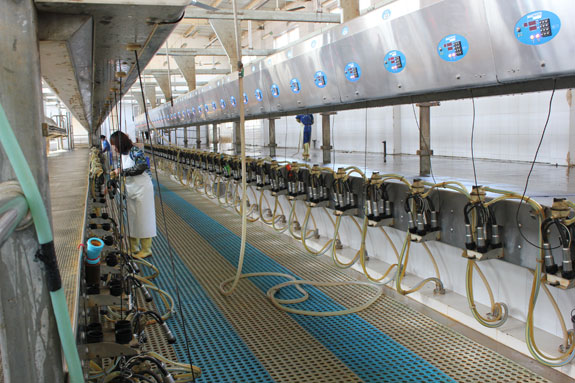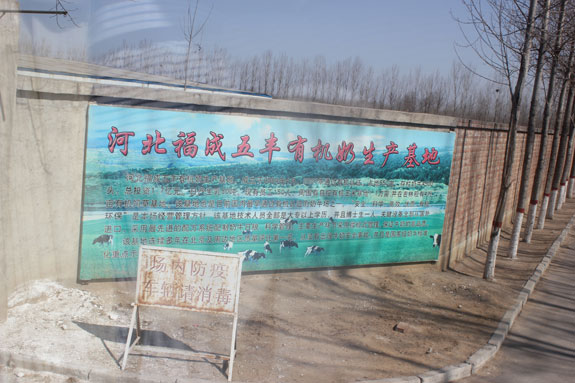This article was #6 of the Top 25 most well-read articles on www.progressivedairy.com in 2012. to jump to the article. It was published in the April 10, 2012 Extra. Click here for the full list of the Top 25. South Dakota State University graduate student Kevin Herrick recently had the opportunity to tour China. His article explored the differences in the Chinese dairy industry from the U.S. as well as the challenges Chinese dairy farmers face.
Q. Since this article was published, have you traveled abroad anywhere else? How would you compare that to your trip to China?
Since the article was published, I completed my degree and accepted a position that has given me the opportunity to visit and learn more about dairying in several countries.
Most notably, I traveled to India and observed dairy and buffalo farms throughout the country. The biggest difference that I observed between Chinese and Indian dairy farms was the size of the farms.
While China had several large commercial dairies, the vast majority of the farms in India were very small. Additionally, the emphasis on buffalo farming was also a major difference. This clearly demonstrated the flexibility of the dairy industry in India.
Buffalo were much more tolerant to the heat as well as producing milk with a much greater fat content. Buffalo milk contained up to 7 to 8 percent fat, and many consumers purchased milk directly from the buffalo farms.
In my current position, I have grown to appreciate the global scale of the dairy industry. Although there are differences between the U.S. and international dairy industries, there are things that producers could learn from each other.
For example, learning how other regions deal with expensive or alternative feed ingredients may provide options for producers during periods of financial challenges.
—Kevin Herrick, Global Product Manager, Kemin Industries

ARTICLE :
When I heard about an opportunity to participate in an Agriculture International Experience class that was touring China, I thought it would be an excellent opportunity to learn a little more about the dairy and agriculture industry in China.
I was just finishing my Ph.D. degree in dairy science, and I had 10 years of experience in the industry as a consultant and herdsman. Many of my expectations were based on this experience as well as my research and preparation before the trip.
I knew that the Chinese dairy industry was of minor importance compared to the swine and poultry industry. I also knew that the demand for dairy products was still recovering from a melamine outbreak that occurred in 2008. What I didn’t understand until I spent two weeks visiting several agriculture enterprises were the opportunities that the Chinese dairy industry offers.
According to a 2011 report, Fonterra Cooperative Group Ltd. reported that Chinese demand for New Zealand milk products in 2010 surged more than fivefold from 2008 to about 353 million kilograms.
The dairy company forecasted that exports to China will more than double to 950 million dollars by 2020, from 400 million dollars in 2010. Rising incomes and expanding populations fueling demand for protein-rich diets were given as the main forces driving this projected increased demand.

One of my first observations upon arriving in China was the dichotomy of new and old that was present in almost every aspect of Chinese culture to which we were exposed.
There were houses and apartments with no running water that were being preserved in parts of Old Beijing. Meanwhile, other parts of the Beijing landscape were speckled with cranes constructing high-rise apartments and office buildings.
This contrast was also readily apparent in the agriculture industry. One of our first visits was with an agribusiness involved with the agronomy industry in China. During the presentation, the representative told us that in some parts of the country, an average farm was one mǔ (approximately one-sixth of an acre).
The average corn production throughout China is 90 bushels per acre or 60 percent of a U.S. average. This equates to a total annual production of 15 bushels of corn for some farmers. Furthermore, most of the labor was done by hand or with the aid of water buffalo and there was very little mechanical automation. All of these details made myself and the rest of our large group question how such an inefficient system could be viable for feeding China’s population of 1.3 billion.
With this visit fresh in my mind, my expectations for the visit to the dairy farm were very low. However, what I found was an intensive operation that milked more than 4,000 cows in a double-40 parallel parlor that was less than two years old. Furthermore, the dairy operation was part of a large business structure that owned and operated a chain of restaurants and hotels around Beijing, as well as owned one of the largest feedlots in China.
Upon visiting with the dairy manager (a lawyer with a Ph.D. in agriculture) it became apparent that this operation was the exception rather than the rule for most dairies in China. The manager explained how this dairy was modeled after American dairies and that much of the parlor equipment was American-made.
Additionally, the corn silage was harvested with three American self-propelled choppers that the dairy owned. However, many of the challenges limiting production on this dairy (approximately 62 pounds per cow per day), demonstrate the problems that the entire Chinese dairy industry experiences.
The grass hay that was being grown on this dairy was very low quality. A large portion of these quality issues were attributed to the lack of land base and subsequent over application of manure, resulting in poor agronomic conditions. This dairy was large enough that a large proportion of the forage needs were being met with purchased (500 dollars per ton) alfalfa hay from California.
However, the smaller farms that are typical in China would not be able to afford this luxury. These individuals are forced to feed low-quality grass or residues left from grain production.
Another challenge for the dairy industry, as well as other livestock production segments in China, is the lack of genetic potential. The manager explained that prior to 10 years ago there was very little focus on selecting for genetic improvement. As a result, this dairy is trying to catch up with the potential of cattle in America by importing cattle from Australia and putting a greater emphasis on their breeding program.
Another interesting observation was the inefficiencies throughout the dairy. During our tour we saw individuals using shovels and rakes to spread manure on the land used for grass production as well as workers shoveling manure from the exercise lot into push carts. Furthermore, the manager said that there are normally eight to 10 people that are in the parlor during each milking shift.
It was discussed not only by this manager but by other individuals how the Chinese government encourages business opportunities that can demonstrate a greater employment rate. Often this goal of creating more jobs comes at the expense of poorer labor efficiencies. It was noted that during our entire visit which lasted most of one afternoon, we did not see or hear any type of skid-steer or other machine that are so common on most dairies.
Other Chinese dairy farm challenges that were discussed were actually some of the same challenges that American dairies experience. China’s large population has forced more acres towards urban development and less towards agriculture. As a result, farmers are forced to spread more waste on limited acres which eventually causes imbalances in nutrient content of the soil as well as increased surface runoff into the rivers and drinking supplies.
This was readily apparent to our group as during our entire visit we were continually warned to not drink the water because of high bacteria counts. In fact, our tour guides informed us that even native Chinese residents are forced to boil all of their drinking water because the quality is that poor.
After urban sprawl and insufficient land, the next most discussed challenge was availability of feedstuffs. In addition to the previously mentioned limitation of forage, concentrate availability is also becoming a major concern. The combination of increasing grain for human consumption, the need for concentrates for the swine and poultry industry, as well as the reduced grain yield were discussed.
The consensus of opinion was that these issues as well as the government’s policy regarding importation of genetically modified products need to be addressed if continued growth is going to occur.
It was sometimes difficult to envision how American businesses could become involved in this system in a way that the Chinese dairy industry as well as the foreign business could both benefit. Because of the large number of individual farmers and lack of an agriculture extension program, it was apparent that simply providing technology or information on production practices would be insufficient. There are not enough knowledgeable individuals within China that can act as a source of information for all of the individual producers.
Additionally, it became clear during our visits with some agribusinesses as well as our visits to local markets that there is a very large problem with imitation products. This ranges from pirated CDs and DVDs to growing grains on their farm and subsequently bagging and selling the grain as seed under a corporate brand.
There were also anecdotes of failed business attempts to improve production through simply providing equipment or technology. One challenge of the Chinese dairy processing industry is the extremely large bacteria counts related to the poor milking techniques of most producers. It was discussed how a manufacturing plant tried to rectify this problem by providing milking units to several of the dairies supplying milk.
However, bacteria counts increased and it was discovered that because of a lack of hot water, sanitation of the milking equipment was not occurring. This clearly outlined that there is essentially a domino effect that occurs when new technology is implemented. There has to be an anticipation of potential problems and an understanding of how changing one practice or how improving one area of production may have an impact on other non-related issues.
There are indications that the Chinese government is starting to address many of these issues. Every five years the Chinese government develops a plan which outlines the priorities and sets goals to allow for the greatest potential growth.
The latest five-year plan has identified agriculture as one of these areas and as a result there has been increased investment into improving the agriculture system as well as the nutrition for Chinese residents. However, besides an increased monetary investment, specific methods to achieve the goals in the latest five year plan were unknown to most of the individuals involved in our discussions.
It is apparent that companies from countries other than China can be successful working in the agribusiness sector in China. Our group heard several success stories from companies that have an established business in China and are working with Chinese producers and consultants to improve efficiencies and agricultural production.
These companies attributed much of their success to investing time as well as emphasizing working as a partner with departments and Chinese businesses to achieve the goals set out by the government. The final overall impression that I got from most of the individuals that our group met with was a desire to continue to develop the Chinese agriculture industry.
The limitations and weaknesses of the current system were acknowledged by most. However, it was also apparent that these same individuals were willing to work with outside companies and investments to ultimately reach their final goal. PD
Kevin Herrick
Graduate Student
South Dakota State University
Photos by Kevin Herrick.
Related articles:
• How does the Chinese consumer impact me?
• China, credit, consumer choice: PDPW Business Conference





